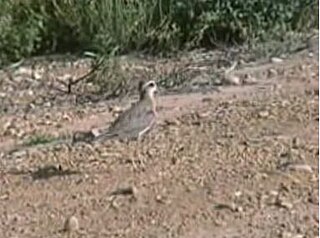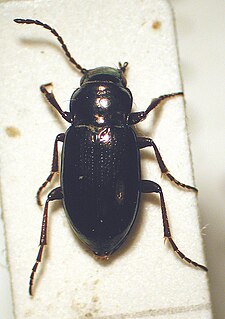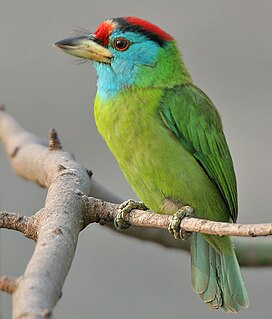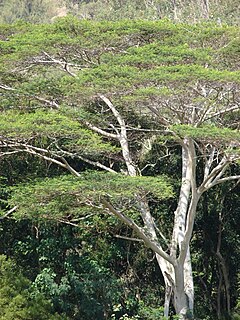
The Caspian plover is a wader in the plover family of birds. The genus name Charadrius is a Late Latin word for a yellowish bird mentioned in the fourth-century Vulgate. It derives from Ancient Greek kharadrios a bird found in ravines and river valleys. The specific asiaticus is Latin and means "Asian", although in binomials it usually means the type locality was India.

Albizia is a genus of more than 160 species of mostly fast-growing subtropical and tropical trees and shrubs in the subfamily Mimosoideae of the family Fabaceae. The genus is pantropical, occurring in Asia, Africa, Madagascar, America and Australia, but mostly in the Old World tropics. In some locations, some species are considered weeds.

The black-necked stork is a tall long-necked wading bird in the stork family. It is a resident species across the Indian Subcontinent and Southeast Asia with a disjunct population in Australia. It lives in wetland habitats and near fields of certain crops such as rice and wheat where it forages for a wide range of animal prey. Adult birds of both sexes have a heavy bill and are patterned in white and irridescent blacks, but the sexes differ in the colour of the iris with females sporting yellow irises and males having dark-coloured irises. In Australia, it is sometimes called a jabiru although that name refers to a stork species found in the Americas. It is one of the few storks that is strongly territorial when feeding and breeding.

The Trachypachidae are a family of beetles that generally resemble small ground beetles, but that are distinguished by the large coxae of their rearmost legs. There are only six known extant species in the family, with four species of Trachypachus found in northern Eurasia and northern North America, and two species of Systolosoma in Chile. They were much more diverse in the past, with many members belonging to the extinct subfamily Eodromeinae, the first fossils known of this family are of the genera Petrodromeus and Permunda from the Permian-Triassic boundary of Russia.

Streptomyces is the largest genus of Actinobacteria and the type genus of the family Streptomycetaceae. Over 500 species of Streptomyces bacteria have been described. As with the other Actinobacteria, streptomycetes are gram-positive, and have genomes with high GC content. Found predominantly in soil and decaying vegetation, most streptomycetes produce spores, and are noted for their distinct "earthy" odor that results from production of a volatile metabolite, geosmin.
In botany, the correct name according to the International Code of Nomenclature for algae, fungi, and plants (ICN) is the one and only botanical name that is to be used for a particular taxon, when that taxon has a particular circumscription, position and rank. Determining whether a name is correct is a complex procedure. The name must be validly published, a process which is defined in no less than 16 Articles of the ICN. It must also be "legitimate", which imposes some further requirements. If there are two or more legitimate names for the same taxon, then the correct name is the one which has priority, i.e. it was published earliest, although names may be conserved if they have been very widely used. Validly published names other than the correct name are called synonyms. Since taxonomists may disagree as to the circumscription, position or rank of a taxon, there can be more than one correct name for a particular plant. These may also be called synonyms.

The blue-throated barbet is an Asian barbet native to the foothills of the Himalayas and Southeast Asia. It inhabits lowland and montane forests at elevations of 200–2,000 m (660–6,560 ft). It has bright green, blue and red plumage. The barbets get their name from the bristles which fringe their heavy bills; this species eats fruits and insects.

The Streptomycetaceae are a family of Actinobacteria, making up the monotypic order Streptomycetales. It includes the important genus Streptomyces. This was the original source of many antibiotics, namely streptomycin, the first antibiotic against tuberculosis.

The Chinese high-fin banded shark is a popular freshwater aquarium fish that belongs to the family Catostomidae. It grows to about 1.35 m long and is unsuitable for most home aquariums.

Falcataria is a genus of flowering plants in the family Fabaceae. It belongs to the monophyletic Mimosoid clade in the subfamily Caesalpinioideae. The genus has three species previously classified in the Falcataria section of the genus Paraserianthes by I.C. Neilsen. The distribution of these closely related species within the genus Falcataria links the wet tropics of north-east Australia to New Guinea, the Moluccas, Bismarck Archipelago, and the Solomon Islands east of Wallace's line similar to other plant taxa from the region.

Paraserianthes is a genus of flowering plants in the family Fabaceae. It belongs to the mimosoid clade of the subfamily Caesalpinioideae.

Falcataria moluccana, commonly known as the Moluccan albizia, is a species of fast-growing tree in the family Fabaceae. It is native to the Maluku Islands, New Guinea Island, the Bismarck Archipelago, and the Solomon Islands. It is cultivated for timber throughout South Asian and Southeast Asian countries. This tree is considered to be invasive in Hawaii, American Samoa and several other island nations in the Pacific and Indian Oceans. It is about 30m tall tree in nature with a massive trunk and an open crown.
Streptomyces cangkringensis is a bacterium species from the genus of Streptomyces which has been isolated from rhizosphere soil from the plant Falcataria moluccana from Yogyakarta from the island Java in Indonesia.
Uromycladium falcatarium is a species of rust fungus in the genus Uromycladium. It was circumscribed by mycologists Doungsa-ard, McTaggart & Shivasin in 2015.
Streptomyces indonesiensis is a bacterium species from the genus of Streptomyces which has been isolated from the tree Paraserianthes falcataria from Yogyakarta on Java in Indonesia.
Streptomyces rhizosphaericus is a bacterium species from the genus of Streptomyces which has been isolated from the ectorhizosphere of the tree Paraserianthes falcataria from Yogyakarta on Java in Indonesia.
Streptomyces yogyakartensis is a bacterium species from the genus of Streptomyces which has been isolated from rhizosphere soil from the tree Paraserianthes falcataria in Yogyakarta on Java on Indonesia.








